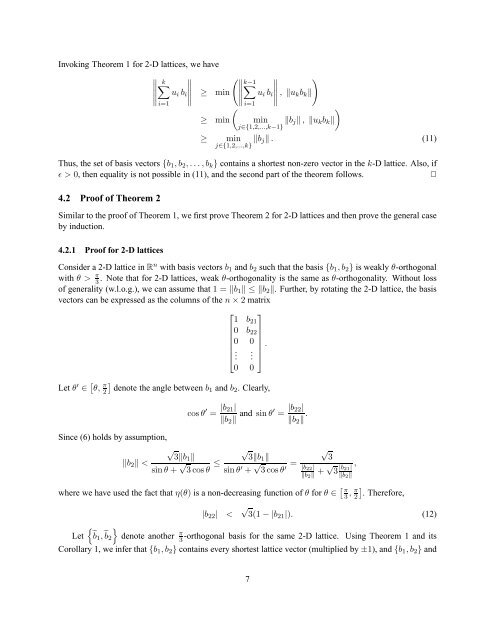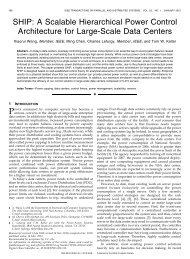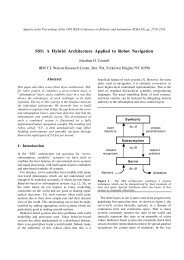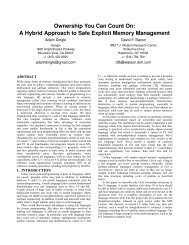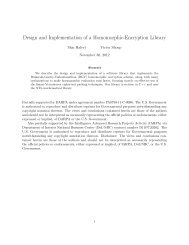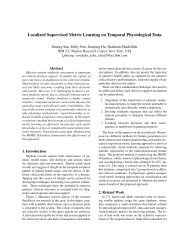4 <strong>Nearly</strong> <strong>Orthogonal</strong> <strong>Bases</strong>: Proofs4.1 Proof of Theorem 1We first prove Theorem 1 for 2-D lattices (Gauss’s result) <strong>and</strong> then tackle the proof for higher-dimensionallattices via induction.4.1.1 Proof for 2-D latticesConsider a 2-D lattice with a basis B = {b 1 ,b 2 } satisfying the conditions of Theorem 1. Let θ ′ denote theangle between b 1 <strong>and</strong> b 2 . Since π 3 ≤ θ′ ≤ π 2by assumption,|〈b 1 ,b 2 〉| = ‖b 1 ‖ ‖b 2 ‖cos θ ′ ≤ ‖b 1‖ ‖b 2 ‖. (9)2The squared-length of any non-zero lattice vector v = u 1 b 1 + u 2 b 2 , with u 1 ,u 2 ∈ Z <strong>and</strong> |u 1 | + |u 2 | > 0,equals‖v‖ 2 = |u 1 | 2 ‖b 1 ‖ 2 + |u 2 | 2 ‖b 2 ‖ 2 + 2u 1 u 2 〈b 1 ,b 2 〉≥ |u 1 | 2 ‖b 1 ‖ 2 + |u 2 | 2 ‖b 2 ‖ 2 − 2|u 1 ||u 2 ||〈b 1 ,b 2 〉|≥ |u 1 | 2 ‖b 1 ‖ 2 + |u 2 | 2 ‖b 2 ‖ 2 − |u 1 ||u 2 |‖b 1 ‖ ‖b 2 ‖ (using (9))= (|u 1 |‖b 1 ‖ − |u 2 |‖b 2 ‖) 2 + |u 1 ||u 2 |‖b 1 ‖ ‖b 2 ‖ (10)≥ min ( ‖b 1 ‖ 2 , ‖b 2 ‖ 2) ,with equality possible only if either |u 1 | + |u 2 | = 1 or θ ′ = π 3. This proves Theorem 1 for 2-D lattices.4.1.2 Proof for higher-dimensional latticesLet k > 2 be an integer, <strong>and</strong> assume that Theorem 1 is true for every (k−1)-D lattice. Consider a k-D latticeL spanned by a weakly ( π3 + ɛ) -orthogonal basis (b 1 ,b 2 ,... ,b k ), with ɛ ≥ 0. Any non-zero vector in L canbe written as ∑ ki=1 u i b i for integers u i , where u i ≠ 0 for some i ∈ {1,2,... ,k}. If u k = 0, then ∑ ki=1 u i b iis contained in the (k − 1)-D lattice spanned by the weakly ( π3 + ɛ) -orthogonal basis (b 1 ,b 2 ,... ,b k−1 ). Foru k = 0, by the induction hypothesis, we have∥ ∥∥ ∥ k∑ ∥∥∥∥ ∑k−1∥∥∥∥ u∥ i b i =u∥ i b i ≥i=1i=1min ‖b j‖ ≥j∈{1,2,...,k−1}min ‖b j‖.j∈{1,2,...,k}If ɛ > 0, then the first inequality in the above expression can hold as equality only if ∑ k−1i=1 |u i| = 1. Ifu k ≠ 0 <strong>and</strong> u i = 0 for i = 1,2,... ,k − 1, then again∥∥ k∑ ∥∥∥∥ u∥ i b i ≥ ‖b k ‖ ≥i=1min ‖b j‖ .j∈{1,2,...,k}Again, it is necessary that |u k | = 1 for equality to hold above.Assume that u k ≠ 0 <strong>and</strong> u i ≠ 0 for some i ∈ {1,2,... ,k − 1}. Now ∑ ki=1 u i b i is contained in the 2-Dlattice spanned by the vectors ∑ k−1i=1 u i b i <strong>and</strong> u k b k . Since the ordered set (b 1 ,b 2 ,... ,b k ) is weakly ( π3 + ɛ) -orthogonal, the angle between the non-zero vectors ∑ k−1i=1 u i b i <strong>and</strong> u k b k lies in the interval [ π3 + ɛ, π 2].6
Invoking Theorem 1 for 2-D lattices, we have∥ (∥ ∥ )k∑ ∥∥∥∥ ∥∥∥∥ ∑k−1∥∥∥∥ u i b i ≥ min u i b i , ‖u∥k b k ‖i=1i=1()≥ min min ‖b j‖, ‖u k b k ‖j∈{1,2,...,k−1}≥min ‖b j‖ . (11)j∈{1,2,...,k}Thus, the set of basis vectors {b 1 ,b 2 ,... ,b k } contains a shortest non-zero vector in the k-D lattice. Also, ifɛ > 0, then equality is not possible in (11), <strong>and</strong> the second part of the theorem follows.✷4.2 Proof of Theorem 2Similar to the proof of Theorem 1, we first prove Theorem 2 for 2-D lattices <strong>and</strong> then prove the general caseby induction.4.2.1 Proof for 2-D latticesConsider a 2-D lattice in R n with basis vectors b 1 <strong>and</strong> b 2 such that the basis {b 1 ,b 2 } is weakly θ-orthogonalwith θ > π 3. Note that for 2-D lattices, weak θ-orthogonality is the same as θ-orthogonality. Without lossof generality (w.l.o.g.), we can assume that 1 = ‖b 1 ‖ ≤ ‖b 2 ‖. Further, by rotating the 2-D lattice, the basisvectors can be expressed as the columns of the n × 2 matrix⎡ ⎤1 b 210 b 220 0.⎢ ⎥⎣ . . ⎦0 0Let θ ′ ∈ [ θ, π 2]denote the angle between b1 <strong>and</strong> b 2 . Clearly,Since (6) holds by assumption,‖b 2 ‖


